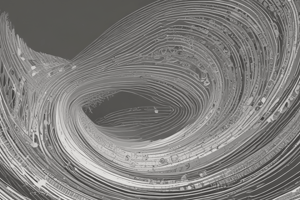Podcast
Questions and Answers
What is the main branch of calculus that deals with the study of rates of change and slopes of curves?
What is the main branch of calculus that deals with the study of rates of change and slopes of curves?
- Differential Calculus (correct)
- Geometry Calculus
- Algebraic Calculus
- Integral Calculus
The Power Rule is used to find the derivative of a function that is the product of two functions.
The Power Rule is used to find the derivative of a function that is the product of two functions.
False (B)
What is the application of calculus in finding the maximum and minimum values of a function?
What is the application of calculus in finding the maximum and minimum values of a function?
Optimization
The ___________ Rule is used to find the derivative of a function that is a quotient of two functions.
The ___________ Rule is used to find the derivative of a function that is a quotient of two functions.
What is the application of calculus in physics and engineering?
What is the application of calculus in physics and engineering?
The area under a curve between two points is an example of an indefinite integral.
The area under a curve between two points is an example of an indefinite integral.
What is the name of the method used to integrate a function by substituting u = f(x) to simplify the integral?
What is the name of the method used to integrate a function by substituting u = f(x) to simplify the integral?
The ___________ Integral is used to find the area under a curve between two points.
The ___________ Integral is used to find the area under a curve between two points.
Study Notes
Calculus
Introduction
- Calculus is a branch of mathematics that deals with the study of continuous change
- It consists of two main branches: Differential Calculus and Integral Calculus
Differential Calculus
- Deals with the study of rates of change and slopes of curves
- Key concepts:
- Limits: the behavior of a function as the input approaches a certain value
- Derivatives: the rate of change of a function with respect to its input
- Rules of Differentiation:
- Power Rule: if f(x) = x^n, then f'(x) = nx^(n-1)
- Product Rule: if f(x) = u(x)v(x), then f'(x) = u'(x)v(x) + u(x)v'(x)
- Quotient Rule: if f(x) = u(x)/v(x), then f'(x) = (u'(x)v(x) - u(x)v'(x)) / v(x)^2
- Applications:
- Finding the maximum and minimum values of a function
- Determining the rate at which a quantity changes over time
Integral Calculus
- Deals with the study of accumulation of quantities
- Key concepts:
- Definite Integrals: the area under a curve between two points
- Indefinite Integrals: the antiderivative of a function
- Integration Rules:
- Substitution Method: substitute u = f(x) to simplify the integral
- Integration by Parts: ∫u(x)v'(x)dx = u(x)v(x) - ∫v(x)u'(x)dx
- Integration by Partial Fractions: break down a rational function into simpler fractions
- Applications:
- Finding the area under curves
- Calculating volumes of solids
- Solving problems involving accumulation of quantities over time
Applications of Calculus
- Physics and Engineering: modeling motion, optimization, and physical systems
- Economics: modeling economic systems, optimization, and growth
- Computer Science: algorithms, data analysis, and machine learning
- Biology: modeling population growth, disease spread, and chemical reactions
Calculus
Introduction
- Calculus is a branch of mathematics that deals with the study of continuous change
- It consists of two main branches: Differential Calculus and Integral Calculus
Differential Calculus
- Deals with the study of rates of change and slopes of curves
- Key concepts:
- Limits: the behavior of a function as the input approaches a certain value
- Derivatives: the rate of change of a function with respect to its input
- Rules of Differentiation:
- Power Rule: if f(x) = x^n, then f'(x) = nx^(n-1)
- Product Rule: if f(x) = u(x)v(x), then f'(x) = u'(x)v(x) + u(x)v'(x)
- Quotient Rule: if f(x) = u(x)/v(x), then f'(x) = (u'(x)v(x) - u(x)v'(x)) / v(x)^2
- Applications:
- Finding the maximum and minimum values of a function
- Determining the rate at which a quantity changes over time
Integral Calculus
- Deals with the study of accumulation of quantities
- Key concepts:
- Definite Integrals: the area under a curve between two points
- Indefinite Integrals: the antiderivative of a function
- Integration Rules:
- Substitution Method: substitute u = f(x) to simplify the integral
- Integration by Parts: ∫u(x)v'(x)dx = u(x)v(x) - ∫v(x)u'(x)dx
- Integration by Partial Fractions: break down a rational function into simpler fractions
- Applications:
- Finding the area under curves
- Calculating volumes of solids
- Solving problems involving accumulation of quantities over time
Applications of Calculus
- Physics and Engineering: modeling motion, optimization, and physical systems
- Economics: modeling economic systems, optimization, and growth
- Computer Science: algorithms, data analysis, and machine learning
- Biology: modeling population growth, disease spread, and chemical reactions
Studying That Suits You
Use AI to generate personalized quizzes and flashcards to suit your learning preferences.
Description
Explore the basics of calculus, including its definition, branches, and key concepts in differential calculus such as limits, derivatives, and rules of differentiation.




